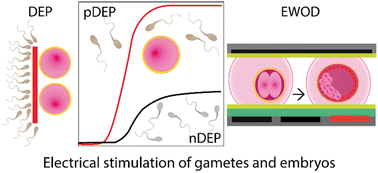Electrically-driven handling of gametes and embryos: taking a step towards the future of ARTs
Abstract
Electrical stimulation of gametes and embryos and on-chip manipulation of microdroplets of culture medium serve as promising tools for assisted reproductive technologies (ARTs). Thus far, dielectrophoresis (DEP), electrorotation (ER) and electrowetting on dielectric (EWOD) proved compatible with most laboratory procedures offered by ARTs. Positioning, entrapment and selection of reproductive cells can be achieved with DEP and ER, while EWOD provides the dynamic microenvironment of a developing embryo to better mimic the functions of the oviduct. Furthermore, these techniques are applicable for the assessment of the developmental competence of a mammalian embryo in vitro. Such research paves the way towards the amelioration and full automation of the assisted reproduction methods. This article aims to provide a summary on the recent developments regarding electrically stimulated lab-on-chip devices and their application for the manipulation of gametes and embryos in vitro.

- This article is part of the themed collection: Lab on a Chip HOT Articles 2022


 Please wait while we load your content...
Please wait while we load your content...